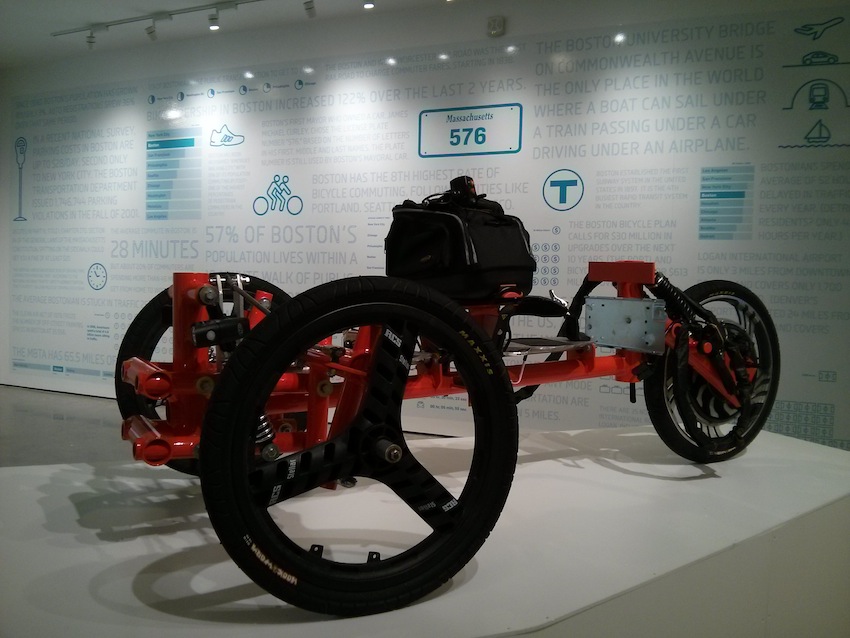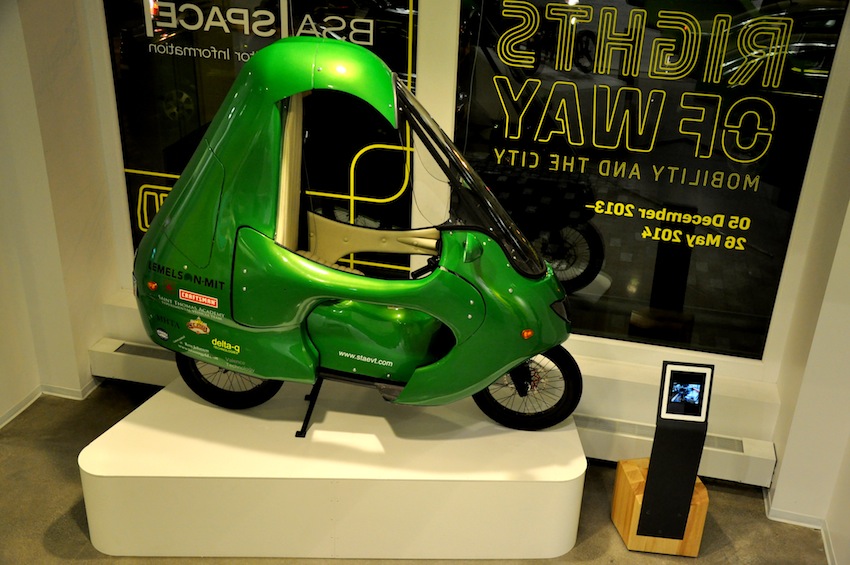The Future of Transportation Could Include a Skateboard-Meets-Segway Hybrid Vehicle

Photo courtesy of Höweler + Yoon Architecture.
As the MBTA focuses on small changes to the transit system in the current decade, architects and inventors from around the city have their eyes on what lies ahead for Boston’s transportation system, and their concepts are on display.
The Boston Society of Architects gallery, BSA Space, is hosting a “future-oriented” show on transformative transportation, called “Rights of Way: Mobility and the City.”
Curated by James Graham and Meredith Miller of MILLIGRAM-office, an architecture firm based out of New York, the gallery display looks at the ways our urban environment constantly shifts, and how those changes need to be balanced between different individuals working in a variety of professional sectors.
From designers, to policy makers, business owners, and residents living in particular cities around the world, public rights are always at play in the shared commons of any landscape.
The gallery is part of “Overhaul: the 2013-2014 Transportation Series,” which was put together by the Boston Society of Architects, the Boston Foundation for Architecture, Boston’s Green Ribbon Commission, and the Barr Foundation, and includes a speaker series as well.
“The exhibition will examine large-scale urban futures, contemporary examples of innovative design for transit and public space, historical attempts at remaking the city, and individual adaptations of mobility systems,” according to a statement from BSA Space.
Miller said there are different elements to the exhibit, such as drawings, renderings, videos, and even live models of what future modes of transportation may look like.
“There is an interesting concept about what transportation could be in 2030, and another is how it has been in the last few years,” she said.
One component is a rendering by architecture firm Höweler + Yoon Architecture, founded by an MIT architecture professor and Harvard Design graduate, which was picked as one of the winners of the 2012 Audi Urban Future Award.
“Audi invited five teams from around the world to do research and proposals for what their city could be like in the year 2030,” said Miller.
One of the machines on display, called the Green Machine, a Vespa-like vehicle, was created by inventors from the Saint Thomas Academy in Minnesota, with help from the Lemelson-MIT program in Cambridge. It was first conceptualized in 2008.
“It’s especially interesting because it’s a compact efficient vehicle. We think of them providing agile short distance service but this one gives it more protection. It’s like a motorcycle with a body,” said Miller.
A skateboard-meets-Segway vehicle is also featured at the Rights of Way show. Miller said the contraption, which looks similar to an off-road vehicle, reacts to a user’s movements.
A third alternative mode of transport that inventors envision in Boston’s future is a “hacked razor scooter with a boost,” Miller said, which comes from the MIT Media Lab.
“They tie in because they can show what people can consider, and that the city doesn’t have to look like it does now. Technologies combined with planning and policy could do a lot to transform our cities,” she said. “All the objects and renderings provide a ‘what if’ and a ‘what could be’ and that’s an interesting thing to be left with—realizing there are all these assumptions about what we have for transportation, and challenging those is part of the job of the show.”
The ongoing event is free, and open to the public, and runs through May.

Photo via BSA Space

Photo via BSA Space


